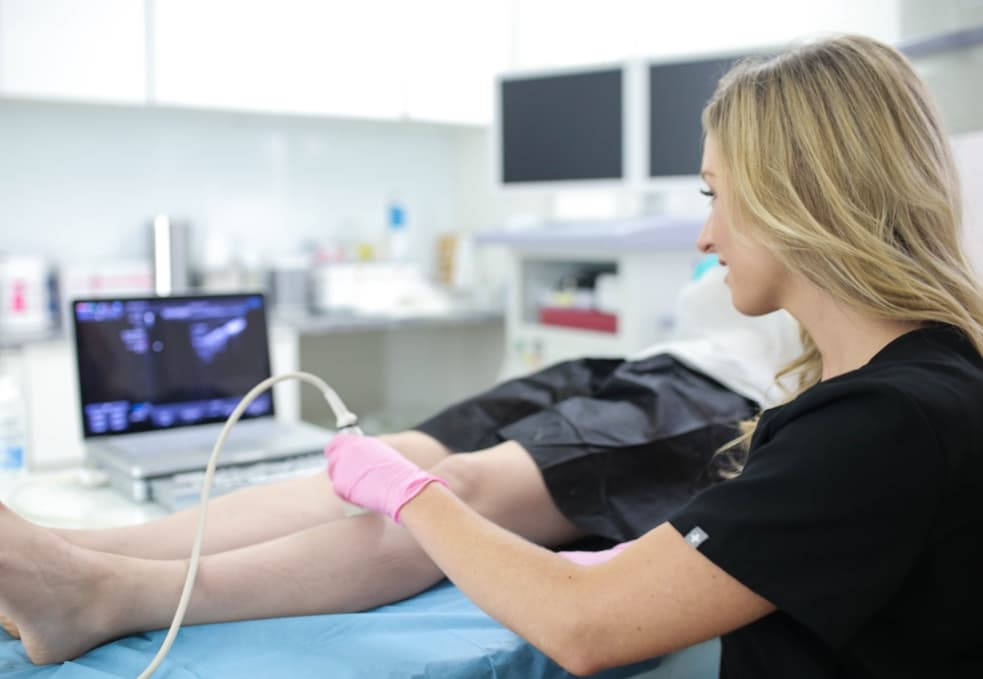Vein Treatment Clinic — best vein center in Rockville Center — describes its diagnosis and treatment process.
Vein Treatment Clinic LI is the best vein center in Long Island, specializing in the latest minimally invasive vein treatments for spider veins and varicose veins. If you’re looking for a vein center in Rockville Center, you can schedule a consultation with our vein clinic, located on the Montauk Highway on the border of Suffolk County and Nassau County, a breezy 25-minutes drive from Rockville Center, far from the madding crowd of New York City.
Vein Treatment Clinic is widely hailed as one of the best vein centers because we have a perfect track record, and our vein care philosophy focuses on emotional comfort just as much as physical comfort. Dr. Caroline Novak, one of the country’s best board-certified vein doctors, presides as the medical director at our vein treatment center. She has a perfect track record, having successfully performed hundreds of minimally invasive varicose vein treatments.
We’ve come to realize that there are some serious misconceptions about what happens during varicose vein treatments. Most people seem to believe that vein treatments involve surgical procedures. However, vein treatments are actually extremely safe — consisting of in-office minimally invasive procedures that conclude within an hour. Furthermore, the consequence of avoiding vein treatments can be grave — skin disease, leg ulcers, deep vein thrombosis, and so much more.
We want to make sure that everyone knows exactly what happens during minimally invasive vein treatments. To that end, we’ve written this article to shed light on what happens during the diagnosis and treatment of varicose veins at our vein center in Rockville Center.

Step 1: Diagnosis of the root cause of spider veins and varicose veins.
Varicose veins and spider veins are caused by an underlying circulatory disorder called venous insufficiency — a condition in which your vein valves collapse and blood accumulate in your leg veins. During your initial consultation at our vein center in Rockville Center, our vein doctor will determine if you have underlying vein disease.
During your initial consultation, the vein doctor will look for signs and symptoms of vein disease, such as restless legs, frequent leg cramps, throbbing leg veins, and leg swelling. If you have advanced vein disease, they may also identify complications like varicose veins, skin disease, skin discoloration, leg ulcers, or deep vein thrombosis.
Following the initial consultation, the vein doctor will use Duplex Ultrasound to visualize the direction of the blood flow in your leg veins. Vein disease leads to venous reflux, i.e., blood flows backward to accumulate in your leg veins. The vascular imaging test will determine if you have venous insufficiency, and it will help the vein doctor identify the diseased saphenous vein.
Step 2: Discussion of vein treatments and insurance coverage.
After the diagnosis of vein disease, the vein doctor will discuss your vein treatment options and insurance coverage.
If you don’t have underlying vein disease, the vein doctor will recommend ambulatory phlebectomy or sclerotherapy to remove the superficial varicose veins and spider veins. If you have underlying vein disease, the vein doctor will recommend radiofrequency ablation, endovenous laser ablation, or VenaSeal to remove the diseased vein.
Your vein doctor will also discuss insurance coverage, which is only available for certain treatments deemed medically necessary. After discussing your options, the vein doctor will curate the ideal vein treatment plan.
Step 3: Vein treatments for varicose veins.
Radiofrequency ablation, endovenous laser ablation, and VenaSeal are the best vein treatments for varicose veins. All of these varicose vein treatments have the same underlying purpose — closing the diseased saphenous vein to allow the accumulated blood to flow to healthier veins. However, they go about it using different methods.
Radiofrequency ablation is the use of thermal energy, channeled via a catheter, to collapse the diseased saphenous vein. Endovenous laser ablation is the use of laser energy, channeled via a laser fiber, to destroy the diseased saphenous vein. VenaSeal is the use of medical adhesives to seal the diseased saphenous vein’s walls, turning it into scar tissue that gets absorbed by the body.
All of these varicose vein treatments are minimally invasive, non-surgical, cause minimal pain or discomfort, and they conclude within an hour with no downtime. However, radiofrequency ablation and endovenous laser ablation are the only vein treatments eligible for insurance coverage.
Step 4: Vein treatments for spider veins.
After the primary varicose vein treatment, you may still have visible spider veins and varicose veins on the surface of your skin. The vein doctor will use ambulatory phlebectomy or sclerotherapy to remove the superficial veins left after the treatment.
Ambulatory phlebectomy is the physical removal of superficial varicose veins through incisions on the skin. Sclerotherapy is the use of a medicine called sclerosant to seal the spider veins’ walls, turning them into scar tissues that eventually get absorbed by the body.
Step 5: Discharge after the diagnosis and treatment of vein disease.
Minimally invasive vein treatments are in-office and outpatient procedures, i.e., they conclude within an hour with no downtime. Furthermore, there’s no hospitalization necessary either. As such, after the varicose vein treatment, the vein doctor will discuss after-care and provide compression stockings.
Schedule your vein treatments today.
Vein Treatment Clinic is the best vein center in Rockville Center because we provide the latest minimally invasive vein treatments for spider veins and varicose veins. For more information, please schedule your vein treatment today.

